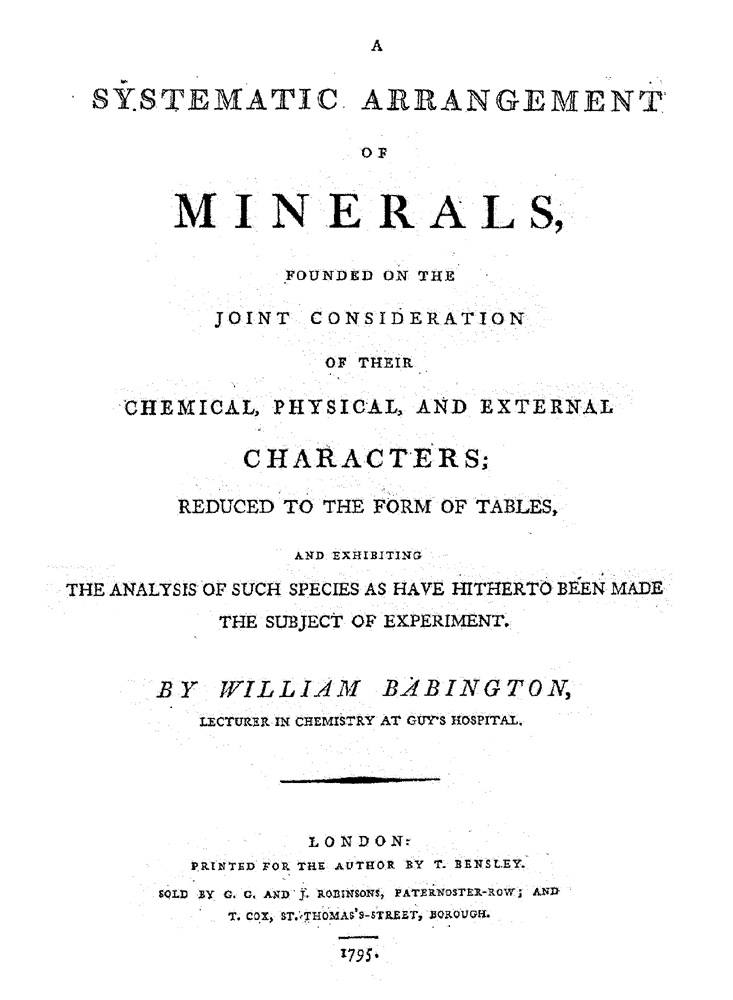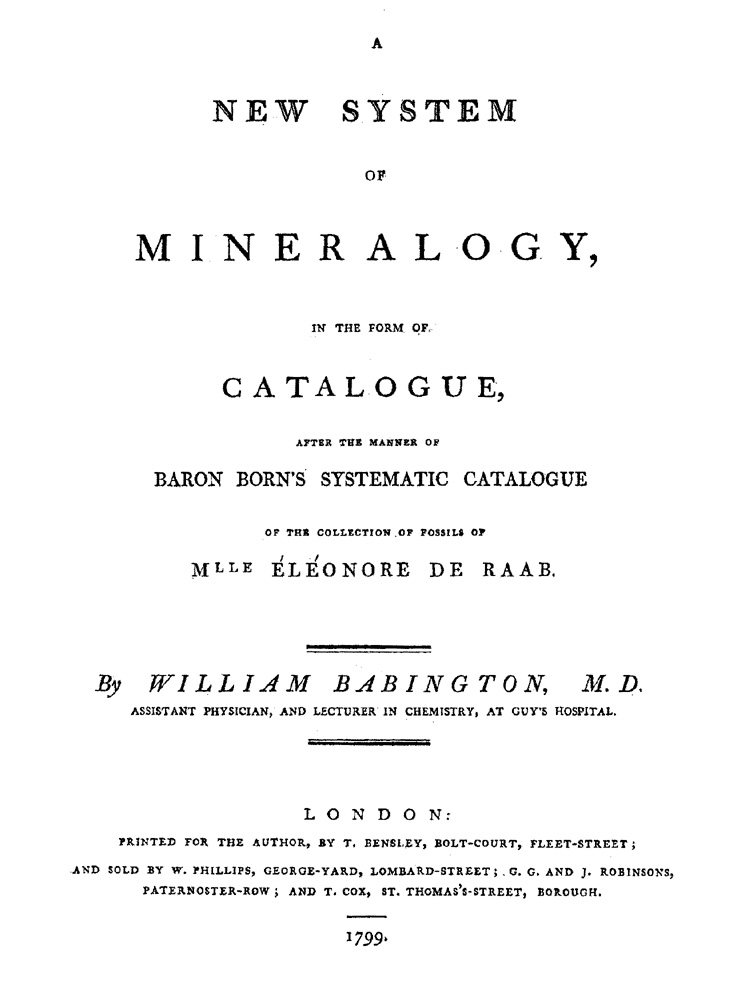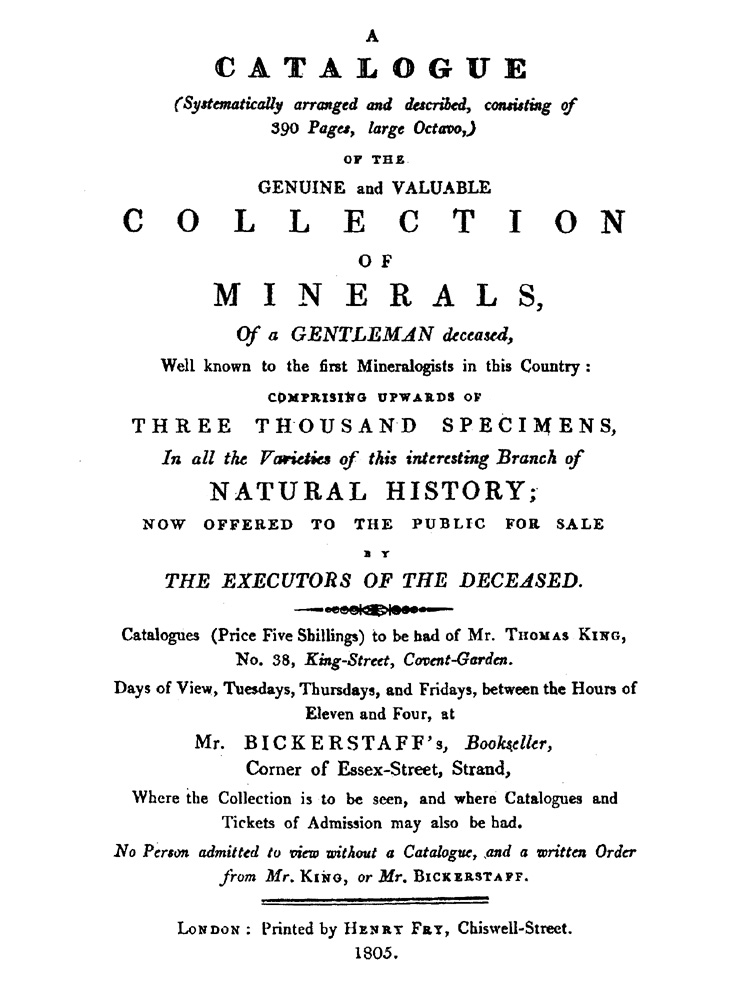BABINGTON, William.
(1756 – 1833)
In 1797, Babington began practicing medicine in London. He also was associated with Guy's Hospital, where he lectured on chemistry. Babington was a founding member of the Geological Society of London, of which he was also elected president in 1822. He was elected a Fellow of the Royal Society of London in 1805, as well as a Fellow of the Royal College of Physicians, and founder of the Hunterian Society in London. The mineral "Babingtonite" was named after him by A. Lévy in 1824.
Biographical references: Barr, Index to Biographical Fragments, 1973: 11. • BBA: I 50, 186-204; II 1268, 103-113. • Dictionary of Irish Biography. • DNB: 2, 315. • DSB: 1, 359-60 [by V. Eyles]. • Poggendorff: 1, cols. 82-3. • Proceedings of the Geological Society, London: 2 (1838), 42-4. • Proceedings of the Royal Society of London: 3 (1830-7), 227-8. • Sarjeant, Geologists, 1980: 2, 457. • Thomas, Dictionary of Biography, 1884: 245. • WBI. • Wills, British Physicians in Geology, 1935 [Babington is dealt with on pages 206-7.]. • Wilson, History of Mineral Collecting, 1994. • Woodward, History of the Geological Society, 1907: 6-11, portrait. • World Who's Who in Science: 82.

1. English, 1795 [First edition].
A | Systematic Arrangement | Of | Minerals, | Founded On The | Joint Consideration | Of Their | Chemical, Physical, And External | Characters; | Reduced To The Form Of Tables, | And Exhibiting | The Analysis Of Such Species As Have Hitherto Been Made | The Subject Of Experiment. | By William Babington, M.D. | Lecturer In Chemistry At Guy's Hospital. | [ornate rule] | London: | Printed For The Author By T. Bensley. | Sold By G.G. and J. Robinson's, Paternoster-Row; And | T. Cox, St. Thomas's-Street, Borough. | [rule] | 1796.
2°: [a]2 B-G2 H1; 15l.; [i]-iv, [1]-26 p. Page size: 265 x 205 mm.
Contents: [i-ii], Title page, verso blank.; [iii]-iv, "Advertisement."; [1]-25, Text, consisting of a series of tables.; 26, "Appendix." and "Errata."
Rare. Babington purchased the the Earl of Bute's mineral collection, which was called one of "the finest, perhaps, which at that time existed in England." The study of these minerals, and the various methods in which they could be classified lead the author to prepare his own collection catalog. It is the arrangement Babington adopted for this catalog that the tables of A Systemtatic Arrangement of Minerals are based.
Bibliographical references: BL [459.a.23.]. • Hoover Collection: no. 69. • NUC: 28, 512 [NB 0006156]. • Roller & Goodman, Catalogue, 1976: 1, 65.
2. English, 1796 [2nd edition].
A | Systematic Arrangement | Of | Minerals, | Founded On The | Joint Consideration | Of Their | Chemical, Physical, And External | Characters; | Reduced To The Form Of Tables, | And Exhibiting | The Analysis Of Such Species As Have Hitherto Been Made | The Subject Of Experiment. | By William Babington, M.D. | Lecturer In Chemistry, And Assistant Physician At Guy's Hospital. | [double rule] | Second Edition. | [double rule] | London: | Printed For T. Cox, at his Medical Library, St. Thomas's-Street, Borough. | And Sold By C.C. and J. Robinson's, Paternoster-Row; | J. Johnson, St. Paul's Church-Yard; And Murray And Highly, Fleet-Street. | [double rule] | 1796.
2°: [a]2 B-G2 H1; 15l.; [i]-iv, [1]-26 p. Page size: 265 x 205 mm.
Contents: [i-ii], Title page, verso blank.; [iii]-iv, "Advertisement."; [1]-25, Text, consisting of a series of tables.; 26, "Appendix." and "Errata."
Rare. Originally compiled for Babington's personal use to arrange his own collection of minerals. It is based upon the system of classification proposed in Baron Iganz Edler von Born's Catalogue Méthodique et Raisonné de la Collection des Fossiles de Mlle Élénore de Raab (2 vols., Vienne, 1790), with the classes, orders, genera and species being founded on chemical distinctions, while varieties are distinguished by external characteristics. "... The whole, therefore, meant to exhibit a comprehensive view of mineralogical arrangement, according to the latest and best writers on the subject." The text of the work is a series of tables that have column headings of "Order," "Genus," "Species," "Variety" and "Analysis." Within the tables, the minerals are then grouped into the four classes: salts, earths, metals and inflammables. An appendix classifies volcanic productions.
Bibliographical references: BMC: 1, 79. • LKG: XII 141. • NUC: 28, 512 [NB 0006157].

3. English, 1799.
A | New System | of | Mineralogy, | in the Form of | Catalogue, | After the Manner of | Baron Born's Systematic Catalogue | of the Collection of Fossils of | Mlle Éléonore de Raab. | [double rule] | By William Babington, M.D. | Assistant Physician, and Lecturer in Chemistry, at Guy's Hospital. | [double rule] | London: Printed for the Author, by T. Bensley, Bolt-Court, Fleet-Street; | and Sold by W. Phillips, George-Yard, Lombard-Street; G.G. and J. Robinsons, | Paternoster-Row; and T. Cox, St. Thomas's • Street, Borough. | [rule] | 1799.
4°: [A]4 B-Z4 2A-2N4 O2 P2; 148l.; [i-ii], [iii]-viii, [1]-279, [1] blank, [8] index p. Pages i-ii containing the half title were missing from all except one copy examined. Page size: 264 x 202 mm.
Contents: [i-ii], Half title page, "A | New System | Of | Mineralogy," verso blank.; [iii-iv], Title page, verso blank.; [v], Dedication to Sir John St. Aubyn, signed W. Babington, 1 October 1799.; [vi], Blank.; [vii]-viii, "Advertisement."; [1]-279, Text.; [1 pg], Blank.; [8 pgs], "Index."-at end, "Printed by T. Bensley, Bolt-court, Fleet-street, London."
Very scarce. In the advertisement, Babington writes that he wishes this work to be considered a continuation of his A Systematic Arrangement of Minerals (1st ed., London, 1795). Like its predecessor, A New System of Mineralogy also uses the mineral collection Babington had purchased from the Earl of Bute on which to form the basis for creating the classification. However, where the earlier publication contained a synopsis of the classification scheme with essentially no mineral descriptions, this work is essentially the expanded descriptive catalog of the specimens arranged according to the system.
The work is dedictated to the mineral collector Sir John St Aubyn [see note below]. Babingtion's obligation to Baron Ignaz Edler von Born is expressed on the title page. In crystallization he was influenced by Jean-Baptiste Louis Romé de l'Isle, while most of his descriptions correspond with those of Johann Friedrich Wilhelm Widenmann and Ludwig August Emmerling. Richard Kirwan was relied upon for the chemical properties and analysis. Babington defines his classes, orders, genera, and species upon the chemical qualities, and his varieties on the external characters of minerals.
Sir John St Aubyn. (Born: 1758; Died: 1839) English politician. St Aubyn was educated at Westminster. He became sheriff of Cornwall in 1781, and a member of parliment from Truro, Cornwall in 1784. He was a Fellow of the Linnean and Royal Societies. His portrait was painted by Reynolds. St Aubyn purchased William Babington's mineral collection for the considerable sum of £3,000. After several subsequent acquisitions, including in 1799 Richard Greene's collection for £100, St Aubyn donated the bulk of the collection to the Civil and Military Library at Davenport in 1834. Through the years it was moved several times, eventually ending up in Plymouth in 1924. There the remains of it are today in the Plymouth City Museum.
Bibliographical references: BMC: 1, 79. • DSB: 1, 359-60 [by V.A. Eyles]. • LKG: XV 28d. • Nicholson's Journal: 3 (1800), 428. • NUC: 28, 512 [NB 0006149]. • Smith, Early Mineralogy in Great Britain, 1978: 60. • Ward & Carozzi, Geology Emerging, 1984: no. 92. • Wills, British Physicians in Geology, 1935: 206-7. • Woodward, History of the Geological Society, 1907: 11. (St Aubyn) American Journal of Science: 1st Series, 40 (1840-1), 220. • Cleevely, World Palæontological Collections, 1983: 253. • DNB: 1, 121. • Proceedings of the Geological Society, London: 1840, 57-8. • Report of the Royal Cornwall Polytechnic Society: 4 (1921-2), 130. • Smith, Early Mineralogy in Great Britain, 1978: 53.

4. English, 1805 [Sale catalog].
A | Catalogue | (Systematically arranged and described, consisting of | 390 Pages, large Octavo,) | Of The | Genuine and Valuable | Collection | Of | Minerals, | Of a Gentleman deceased, | Well known to the first Mineralogists in this Country: | Comprising Upwards Of | Three Thousand Specimens, | In all the Varieties of this interesting Branch of | Natural History; | Now Offered To The Public For Sale | By | The Executors Of The Deceased. | [ornate rule] | Catalogues (Price Five Shillings) to be had of Mr. Thomas King, | No. 38, King-Street, Covent-Garden. | Days of View, Tuesdays, Thursdays, and Fridays, between the Hours of | Eleven and Four, at | Mr. Bickerstaff's, Bookseller, | Corner of Essex-Street, Strand, | Where the Collection is to be seen, and where Catalogues and | Tickets of Admission may also be had. | No Person admitted to view without a Catalogue, and a written Order | from Mr. King, or Mr. Bickerstaff. | [double rule] | London: Printed by Henry Fry, Chiswell-Street. | 1805.
8°: 318, 28, xxxvii p.
Very rare. The authorship of this catalog is attributed to Babington based upon a manuscript notation in the British Library copy. It describes a rich and varied collection of minerals, "selected with much Science and Expence from several valuable Collections, especially the well-known Butean ... the Museum Geversianum and of Professor Gaubius in Holland ... together with an interesting Series of Specimens from Mont Blanc, collected by Mr. Voigt" (Address). The catalog follows the classification scheme outlined in Babinton's previously published works [see previous entries].
The whole collection is described as being contained in three Mahogany cabinets, each 6 feet tall, 2.5 feet wide and 1.5 feet deep, with 42 drawers in each cabinet. Specimens are fully cataloged including the country locality. The collection was truly world wide in its nature, and the result of great enthusiasum on the part of the collector. Unfortunately, no reference has been found to specifically identify who this individual was. However, based upon the shear size and variety of the collection, the compiler suspects it to be the product of the famous gentleman mineralogist William Withering [see note below].
William Withering. (Born: Wellington, Shropshire, England, 28 March 1741; Died: Larches near Birmingham, England, 6 October 1799) English physician. Withering graduated with his M.D. from the University of Edinburgh in 1766. In 1774, he then opened a medical practice in Birmingham. He was the first to describe native barium carbonate, later named after him as the mineral species, witherite. Withering is best known as a botanist, and his work on the foxglove is a classic. He was elected a Fellow of the Royal Society of London in 1784. He had collections of both minerals and plants.
Bibliographical references: BL [990.h.24.]. • NUC [no copy listed]. (Withering) BBA: I 1187, 210-231. • DNB. • DSB: 14, 463-5 [by W.F. Bynum]. • Partington, History of Chemistry, 1961-70: 3, 299-300. • Poggendorff: 2, cols. 1343-4. • WBI. • Wilson, History of Mineral Collecting, 1994: 198.
.